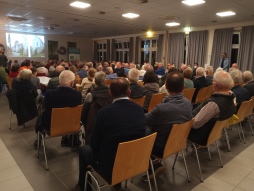Lecture on brickworks in Bocholt full success
130 interested people and two contemporary witnesses visit the Biemenhorst community center
A lecture by Maria Bußkamp and Heinrich Tepasse in cooperation with the historian Dr. Marius Lange was met with great interest. As part of the series of events "Stadtgeschichte vor Ort", the talk was about the history of the brickworks in Bocholt in 1889.
130 interested people from Bocholt came to the Biemenhorst Civic Center to learn about how the brickworks shaped the townscape of Biemenhorst and Lankern as part of Bocholt's 800th anniversary. Among them were two contemporary witnesses who still reported on earlier experiences in the discussion round.
The emergence of brickworks
Starting in 1889, six brickworks were founded in Biemenhorst and Lankern. In the following years, a few more factories followed, such as the weaving mill Gebr. Vagedes, the machine factory Pieron, the motorcycle factory of Alois Beuker and later the weaving mill Gebr. Vehorn. As an important industrial location in the later Liedern-Werth district, Biemenhorst clearly stood out from the other communities that had only belonged to Bocholt since 1975, such as Barlo, Hemden and Mussum.
Maria Bußkamp and Heinrich Tepasse from Biemenhorst initially placed the history of the Bocholt brickworks as an important chapter in the town's history in the context of industrialization. When more and more factories were founded in Bocholt after the introduction of the steam engine, countless factory workers flocked to the city to find work. One thing was indispensable for the newly forming city quarters: bricks. Bußkamp and Tepasse proved that the brickworks thus had an enormous influence on Bocholt's urban development and townscape: The "Bocholt brick" is considered a local trademark beyond the city limits.
Biemenhorst as a business location
Special mention was made of the importance of the brickmaking industry for Biemenhorst as a business location. The settlement of brickworks had an enormous impact on the population development and the structural expansion of Biemenhorst. It was reported, for example, how the influx of brickyard workers greatly increased the Biemenhorst population from the end of the 19th century. Finally, the brickyards were of great importance as employers for what is now the southern part of the city. One of the brickworks already employed a proud 90 people at the turn of the century.
Contemporary witnesses
Most of the brickworks ceased operations in the 1960s. But even today, traces of this former industrial culture can still be found in Biemenhorst. In the discussion that followed, two listeners came forward as contemporary witnesses to report on everyday working life and amusing anecdotes from the brickworks.



